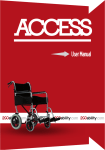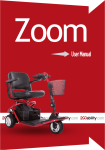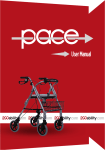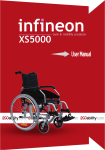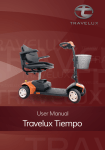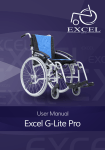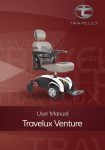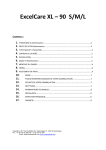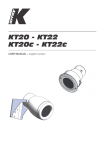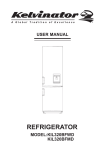Download User Manual
Transcript
User Manual BEFORE USING YOUR NEW 2GOABILITY BOOST SCOOTER YOUMUST READ AND FULLY UNDERSTAND THIS MANUAL General information You have just purchased an 2GOability Boost scooter and we want to thank you for the confidence in our 2GOability products. The Boost scooter is a quality product. The policy of 2GOability is to continually improve the quality and reliability of our products. We reserve the right, therefore without prior notification, to alter this guide. It is important that your guide for the use of the Boost scooter is read carefully. The manual contains important information about the safe use and maintenance of your Boost scooter. We recommend that you keep this guide, it is also your proof of warranty and you will find it useful for referring to it at a later date. The safety instructions in this guide are general guidelines that must be seen as broad guidelines. Your new 2GOability Boost scooter requires frequent maintenance, much of which you can do yourself. Caution! In this guide you will find information and warnings. These are clearly identified by the symbols below and the appearance of the text: Tip Information Warning To avoid personal injury, warnings must be followed 1 Fill out the information on your authorized dealer below: Company: ………………………………………………………………… Address: ………………………………………………………………… ………………………………………………………………… Telephone number: ………………………………………………………………… Fax number: ………………………………………………………………… Email address: ………………………………………………………………… Website: ………………………………………………………………… 2 1 IDENTIFICATION ....................................................................................... 4 2 GENERAL EXPLANATION CONCERNING YOUR SCOOTER ........................ 5 2.1 COMPONENTS OF THE SCOOTER .............................................................................5 2.2 GENERAL EXPLANATION OF THE FUNCTION AND POSSIBILITIES OF YOUR BOOST SCOOTER .........6 3 SAFETY REGULATIONS .............................................................................. 6 3.1 GENERAL SAFETY REGULATIONS .............................................................................6 3.2 WARNINGS FOR SAFE USE ....................................................................................6 4 INSTRUCTIONS FOR USE .......................................................................... 7 4.1 TILLER CONTROL PANEL ......................................................................................8 4.2 GETTING ON AND OFF ........................................................................................9 4.3 SET UP ........................................................................................................ 10 4.4 BASIC DRIVING .............................................................................................. 11 4.5 STEERING .................................................................................................... 11 4.6 CONTROL THROUGH TIGHT SPOTS ........................................................................ 12 4.7 GOING UP AN INCLINE / DOWN A DECLINE ............................................................... 13 4.8 EMI / RFI ................................................................................................... 15 5 INSTRUCTIONS FOR USE AND MOUNTING OPTIONS ............................ 16 5.1 TECHNICAL INFORMATION.................................................................................. 16 5.2 ARMREST ADJUSTMENTS.................................................................................... 17 5.3 SEAT ADJUSTMENTS ......................................................................................... 18 5.4 TILLER ........................................................................................................ 19 5.5 DISASSEMBLY ................................................................................................ 19 5.6 ASSEMBLY .................................................................................................... 22 6 TRANSPORT AND TRANSIT IN CAR ........................................................ 23 7 CARE AND MAINTAINANCE ..................................................................... 24 8 PROBLEM ANALYSIS AND SOLUTIONS ................................................... 25 9 WARRANTY .............................................................................................. 26 9.1 WARRANTY APPLICATION .................................................................................. 26 9.2 WARRANTY DEFINITION .................................................................................... 26 10 GENERAL MAINTENANCE INSTRUCTIONS .......................................... 27 3 1 IDENTIFICATION Your Boost scooter is equipped with a unique serial number. You can find this number on the frame of your Boost scooter. Below is an example of the frame label on which you can find the identification number. Furthermore you will find the explanation of the various data stored on the frame label listed below. 2 5 1 6 4 3 7 1. Production date Production date of the Boost scooter 2. Serial number The unique serial number. You must have this number when making technical requests or if warranty parts are required. 3. Maximum user weight The largest occupant weight allowed for protection of both the Boost scooter and the user. 4. Type number This number indicates which model of Boost scooter you have, again this is always required when making technical calls. 5. Model name The model name of your Boost scooter. 6. Description Description of the design of your scooter. 7. Warranty This is the warranty period. Chapter 9 describes your warranty terms and conditions in more detail. 4 2 GENERAL EXPLANATION CONCERNING YOUR SCOOTER 2.1 Components of the scooter 1 11 10 2 9 3 8 4 7 5 6 1 2 3 4 5 6 Seat Armrest Seat tube Battery pack Rear wheel Front wheel 7 8 9 10 11 Tiller lock knob Tiller adjustment knob Basket Handgrip Control panel Your Boost scooter is equipped with a number of elements and parts. You should know these before continue reading this manual. Designs and specifications may change without prior notice. 5 2.2 General explanation of the function and possibilities of your Boost scooter The Boost scooter is equipped with multifunction brakes and stable wheels which roll easily. The Boost scooter is especially developed so that it can be adjust to every individual user. Your Boost scooter is a medical equipment product and is not a standard consumer product. You must follow this manual completely to ensure good, optimal and safe use of your Boost scooter. 3 SAFETY REGULATIONS 2GOability specifically disclaims responsibility for any body injury or property damage which may occur during any use which does not comply with laws or ordinances. If used correctly, the 2GOability Boost scooter is an utmost safe and stable product, if the instructions for use as described in this manual are followed. However, it is possible when the 2GOability Boost scooter is not used correctly, dangerous situations may occur. 3.1 General safety regulations Protect your 2GOability Boost scooter by checking it regularly. When a part of your Boost scooter is not functioning properly, a dangerous situation could occur. Warning: You must keep your Boost scooter in a good state to guarantee safe use. 3.2 Warnings for safe use Warnings: Failure to follow all the instructions in this manual may result in damage to the scooter or serious injury; Always operate your scooter with thought, care and safety; Do not drive into curbs; Never connect anything to the wheels; The maximum weight capacity has been indicated on your scooter frame label; Unauthorized modification and or use of parts not supplied by 2GOability will invalidate the warranty of this scooter and may lead to injury to the user and or damage to the scooter; Before using your scooter, always check if the brakes are working perfectly; Do not let children play with or on your scooter; Do not use the scooter when the brakes are not working; 6 All wheels must be in contact with the floor at all times during use. This will ensure the scooter is properly balanced; Do not turn your scooter suddenly at full speed; Do not use your scooter when it is damaged or has any malfunction; Do not attempt to use your scooter on an escalator. Always use an elevator; Do not carry passengers under any circumstances; Do not mount or dismount your scooter unless the brake is engaged; Always make sure that the key switch is set to “Off” before mounting or dismounting your scooter; Do not drive backwards with your scooter on an incline or across an uneven surface; Always make sure the seat is locked forward before operating your scooter; Always come to a full stop before changing direction from forward to reverse or from reverse to forward; Do not operate your scooter where you could not safely or legally walk; Do not climb ramps or curbs that exceed your scooters capacity; Always approach inclines straight on; Always be aware of and careful near mechanical pinch points especially when assembling and disassembling your scooter; Never sit on your scooter when it is being transported; Always fasten down your scooter securely with an approved tie-down system while transporting your scooter; Never operate your scooter if it is not functioning properly; Always use caution when driving on soft or uneven surfaces such as grass and gravel. Also use caution on decks where there is no railing; Always cross streets at intersections and use crosswalks or the most direct route, making sure that your path is clear and that you are visible to motor traffic; Never back up or down a step or curb; Never drive your scooter up or down a step or curb that is higher than 4cm; Never drive your scooter over a gap greater than 7.5 cm; Do not drive your scooter in icy of salted conditions; Never drive on the roadway, except when you must cross the street; Never operate your scooter while you are under the influence of alcohol; Always check with your physician to determine if any of the medications you are taking may affect your judgment and/or your ability to operate your scooter. Also check with your physician concerning your physical ability to operate a scooter. 4 INSTRUCTIONS FOR USE Your 2GOability Boost scooter is a battery-operated personal mobility vehicle. Please exercise caution and consideration when you are operating it. Driving your scooter carefully and thoughtfully will help ensure your personal safety and the safety of other people. 7 4.1 Tiller control panel Battery indicator Power Eye Horn Reverse lever Forward lever Speed Control Key Switch Control panel: Key Switch This switch turns the power on and off to your scooter. Insert the key into the key switch; Turn the key 90 degrees clockwise to turn on your scooter´s power; Turn the key back to the vertical position to turn off your scooter's power. Tip Always make certain that the key is removed from the key switch before getting on or off your scooter or before lowering the tiller completely. Speed Control The speed adjustment dial allows you to preselect the maximum top speed of your scooter; Turn the dial counterclockwise to operate your scooter at the lowest speed level; Turn the dial clockwise to increase the operational speed of your scooter; We recommend that you select a speed setting at which you feel comfortable, safe, and in control of your scooter. Forward / Reverse To move forward push the lever on the right side; To move backwards push the lever on the left side. 8 Battery indicator This meter shows the amount of voltage in your scooter’s batteries. Green indicates a full charge on the batteries; Yellow indicates caution and approximately a one-half charge of the batteries; Red indicates that the batteries have less than one-half of a charge remaining. Horn Button Press this button to sound the horn. Power Eye When the scooter is on, and all conditions are normal, the Power Eye will be on. When there is some special situation that needs attention, the light will flash. See chapter 8 for the trouble shooting table. Brakes and throttle lever Whenever the speed engager lever is moved out of the neutral position, the electromagnetic brake will automatically release and your scooter will move. When the speed engager lever is released, it will return to the neutral position and the scooter will decelerate and come to a complete stop. The parking brake will then engage preventing further movement of your scooter. 4.2 Getting on and off Warning: When getting on or off your scooter, keep your weight toward the middle of the deck. Putting most or all of your weight on the edge of the deck may cause an unstable condition! Before getting on your scooter: Check to be certain that the power is turned off. This will eliminate the possibility of accidentally activating the paddle controls and causing injury to yourself or to others; Check to be certain that your scooter’s brake handle is in the engaged position; Flip up the armrests. 9 Getting on your scooter: Position the seat for safe and easy mounting; Return tiller to full upright position; Carefully place one foot on the approximate center of the deck and seat yourself comfortably and securely on the seat; Fasten the seatbelt, if your scooter is so equipped; Flip down or replace the armrests. Getting off your scooter: Make certain that the power is turned off and the key is removed; Return tiller to full upright position; Flip up or remove the armrests; Unfasten the seatbelt; Carefully place one foot on the ground, transfer your weight to that leg, and slowly come to a standing position; Step away from the scooter. 4.3 Set up Tip For your first driving session, make certain that your scooter starts out on a level surface and that you will continue driving on a level surface. To get on your scooter: Stand behind your scooter; Place the scooter in Drive, see picture 1; Make certain that the seat is positioned for safe and easy use; Position yourself in the seat; Use the seat rotate lever to position the seat so that it is locked in the fully forward direction; Fasten your seat belt, if your scooter is so equipped; Place the key into the key switch; Rotate the key to the on position. 10 Warning: Pushing the scooter too quickly in freewheel (picture 1) will cause the motor to act as a generator causing the scooter to become difficult to push; Never set your scooter in freewheel mode when it is on an incline; Never disengage the park brake while you are operating your scooter; Always make certain that your scooter park brake is engaged before inserting the key into the key switch and turning it to the on position. Picture 1 4.4 Basic driving Make certain that you are seated safely and properly on your scooter; Turn the speed control dial fully counterclockwise to its slowest setting; Insert the key into the key switch; Turn the key clockwise to the “On” position; Place your hand on the handgrips; o If you wish to drive forward, pull back on the right side of the throttle control lever; o If you wish to drive in reverse, pull back the left side of the throttle control lever; Pull on the throttle control lever to gently accelerate your scooter; Release the throttle control lever to allow your scooter to come gently to a full stop; Practice these two basic functions until you feel that you have control of your scooter. 4.5 Steering Place both hands on the handgrips of the tiller, turn the tiller to the right to travel to the right; Turn the tiller to the left to travel to the left; Make certain to maintain sufficient clearance when turning your scooter so that the rear wheels will clear any obstacle. 11 Warning: Turning your scooter too sharply at a too high speed will create a situation where one of the rear wheels will leave the ground and the scooter will tip over. Avoid this at any time by decelerating and steering a wide arc around corners and obstacles. Steering in a tight spot If you must steer in a tight spot, such as entering or leaving a doorway or when you are turning around; 1. Bring your scooter to a full stop; 2. Set speed at the lowest setting; 3. Turn the tiller to the direction in which you wish to drive. Steering in reverse Please be extra careful when you are driving in reverse. 1. Use your right fingers to push the throttle control lever or use your left fingers to pull back on the throttle control lever; 2. Turn the tiller to the left to drive in reverse to the left; 3. Turn the tiller to the right to drive in reverse to the right. 4.6 Control through tight spots As you use your scooter to greatly increase your mobility, you will undoubtedly encounter some obstacles that will require practice to manoeuvre smoothly and safely. Below are some common obstacles that you may meet during the daily use of your scooter. Listed with those obstacles are some driving tips that should help you conquer those obstacles. Learn and follow those tips, and with surprising ease you will soon be in control of your scooter as you manoeuvre it through doors, up and down ramps, up and over curbs, through grass and gravel, and up and down inclines. Ramps When proceeding up any ramp, curb, or incline: Lean forward in your seat to move your centre of gravity forward for maximum stability and safety. If the ramp has a switchback, good cornering ability is required: Manoeuvre your scooter so that the front wheels take wide swings around the corners of the ramp. Doing this will allow your scooter's back wheels to follow a wide arc around the corner, staying clear of obstacles. 12 If you must stop your scooter while driving up a ramp: Starting up again simply requires that you apply gentle and steady forward power pressure to the throttle control lever. Accelerate gently after stopping on any incline. Driving down a ramp Keep your scooter’s speed control dial set fully counter clockwise at the slowest speed setting. If you must come to a stop, release the throttle control lever slowly and smoothly. Curbs Do not go up or down a curb that is higher than 4 cm; Always use caution when descending any curb; Approach the curb so that both back wheels of your scooter go over the curb at the same time; Never go down on curbs by traversing them. Doing this will cause the scooter to tip over; Go down a curb slowly to avoid a jarring bump. Use as little power as possible. Grass and Gravel Your scooter performs admirably on grass, gravel, and hills, but you must follow the operational parameters presented in this manual, see chapter 3. If you are unsure about any situation, avoid it. Feel free to use your scooter on lawns or in park areas; Avoid long or high grass, which may wrap around your scooter's axles; Avoid loose gravel. 4.7 Going up an incline / down a decline Driving on inclines For maximum stability, lean forward in your scooters seat while proceeding up ramps, inclines, curbs, or any low rise; Drive with caution when attempting to drive up to any incline, even handicap access ramps; Always climb or descend an incline by driving straight up or straight down the face of the slope; Do not traverse or drive across the face of an incline in any direction; Do not attempt to descend an incline that is covered with snow, ice, cut or wet grass, leaves, or any other potentially hazardous material; Do not back down an incline; Try to keep your scooter moving when climbing an incline. If you do come to a stop, restart and accelerate slowly and carefully; Do not try to descend or climb a slope whose gradient is greater than recommended. The recommended incline is 8°. 13 Warning: If, while you are driving down a slope, your scooter starts to move faster than you feel is safe, release the throttle control lever and allow your scooter to come to a stop. When you feel that you again have control of your scooter, push the throttle control lever forward and continue safely down the remainder of the slope. Driving down a decline Lower speed setting Whenever it is safely possible, drive forward down any ramp, low rise, or incline. 2GOability does not recommend that you drive your scooter in reverse down any incline, ramp, curb, or low rise. Backing down any slope may create a very hazardous situation. If it is necessary to back down a slope follow one of two procedures. Tip When using either of the following procedures to back down a slope, 2GOability strongly advises that you have the assistance of another person. Procedure 1: Under power Set the key switch to the “Off position”; Dismount your scooter; Set the key switch to the “On position”; While standing next to your scooter, carefully operate the controls at the lowest speed setting; Slowly and carefully back your scooter down the incline; Carefully remount your scooter and resume normal operation. Procedure 2: Emergency (No power) Set the key switch to the “Off position”; Dismount your scooter; Set the freewheel lever to “Disengaged”; While standing next to the scooter, carefully manually maneuver it down the slope; When you have reached a level surface at the bottom of the slope, position the freewheel lever in the engaged position; See chapter 7 to restore power. 14 Warning: When your scooter is in freewheel mode, the park brake is released. The weight of the scooter on a slope may cause you to lose control of the scooter. If you do not feel capable of manually controlling your scooter down the slope, request assistance or do not attempt to use this procedure. 4.8 EMI / RFI The rapid development of electronics, especially in the area of communications, has saturated our environment with electromagnetic (radio) waves that are emitted by television transmitters, cellular phones, citizen’s band radios (CBs), amateur radios (ham radios), wireless computer links, microwave transmitters, paging transmitters, etc. These electromagnetic (EM) waves are invisible and increase in strength the closer one gets to the source of transmission. When these energy waves act upon electrical devices and cause them to malfunction or to function in an erratic or uncontrolled manner, they are referred to as Electromagnetic Interference (EMI) of Radio Frequency Interference (RFI). EMI / RFI and your scooter All electrically powered vehicles, including scooters are susceptible to Electromagnetic Interference / Radio Frequency Interference (EMI / RFI). This interference could result in abnormal, unintended movement of your scooter. Warning: Unintended movement or brake release could cause an accident or injury. The FDA has determined that each make and model of scooter can resist EMI/ RFI to a certain level. The higher the lever of resistance, the greater the degree of protection from EMI/ RFI – measured in volts per meter (V/m). The FDA has also determined that current technology is capable of providing 20 V/m of resistance to EMI/ RFI, which would provide useful protection against common sources of interference. This product has been tested and has passed an immunity lever of 20 V/m. 15 EMI / RFI recommendations Do not turn on or use hand-held personal electronic communication devices such as cellular phones, walkie-talkies, and CB radios while your scooter is turned on; Be aware of any nearby transmitters (radio, television, microwave, etc.) on your intended route and avoid operating your scooter close to any of those transmitters; Turn off the power if your scooter is going to be in a stationary position for any length of time; Be aware that adding accessories or components or modifying your scooter may make it more susceptible to EMI/ RFI; If unintended movement or park brake release occurs, turn your scooter off as soon as it is safe to do so. Warning: Turn off your scooter as soon as it is safely possible if unintended or uncontrollable motion occurs or if unintended park brake release occurs. MAKING ADJUSTMENTS TO YOUR SCOOTER CAN CAUSE BIG RISKS FOR YOUR SAFETY AND THE FUNCTION OF YOUR SCOOTER. ADJUSTMENTS MADE BY YOURSELF ARE STRONGLY ADVISED AGAINST AND CARRIED OUT AT YOUR OWN RISK. 5 INSTRUCTIONS FOR USE AND MOUNTING OPTIONS 5.1 Technical information Length Width Front wheels Rear wheels Weight capacity Ground clearance Maximum speed Maximum range Battery pack weight Batteries Weight Weight seat 102 cm 54 cm 7” 8” 115 kg 6,4 cm 7,2 km/h 17 km 13 kg 2 x 18 Ah 45,5 kg 7 kg 16 5.2 Armrest adjustments Armrest width adjustment To adjust the armrest width: Loosen the adjustment knobs at the rear of the seat see picture 2; Slide the armrests in or out to the desired width; Tighten the adjustment knobs. Picture 2 Flip-up the armrests Pull up on the end of either armrest to flip it up for easy transfer on and off your scooter. Armrest angle To increase the armrest angle, turn the armrest angle screw clockwise, see picture 3. To decrease the armrest angle, turn the armrest angle screw counter clockwise. Picture 3 17 5.3 Seat adjustments Seat rotation lever The seat swivel lever (on the side of the seat) allows the seat to rotate in 45º. Pull up on the seat rotation lever up (see picture 4) and rotate the seat to the desired position; Release the handle to lock the seat. Picture 4 Backrest angle To adjust the backrest angle: Grab the backrest at the top; Move the backrest to the desired angle. Picture 5 Tip Fold the back rest down (picture 5) when you’re taking the seat of or when you want to transport your scooter. 18 5.4 Tiller Tiller position adaption You can adjust the position of the tiller: Loosen the tiller adjustment knob; Hold with one hand the tiller while loosening the knob, picture 6; Place the tiller into the desired position; Tighten the knob firmly; Check if the tiller is correctly tightened by moving it back and forth. If it doesn’t move it is correctly tightened. Picture 6 5.5 Disassembly This scooter can be separated into five parts, the front frame, rear frame, basket, battery pack and the seat (picture 7). Each part weighs less than 14 kg. Follow the procedures below to disassemble your scooter and transport it with care. Picture 7 19 Warning: Remove the key from the key switch before you begin to disassemble your scooter! Remove the seat Place your scooter on a level surface; While holding the seat rotation lever up, grab the seat on opposite sides and with a firm grip pull the seat straight up towards you, see picture 8. Picture 8 Remove the battery pack Pull away the black clasp then raise the handle and lift out the battery pack (picture 9); When removing the power pack, please follow the direction of the arrow. Pull it forward and downward first then raise and lift out. In avoiding injury to your hand please be cautious not to bump your hand against the seat post when removing the power pack. Picture 9 20 Separate the front and rear section Push the black clasp to separate the two sections, picture 10. Picture 10 Flipping up the tiller To flip up the tiller you have to follow the below steps: Move the locking knob upwards (picture 11); Flip the tiller up; Move the locking knob downwards to lock the tiller (picture 12). Picture 11 Picture 12 21 5.6 Assembly Combine the front section and rear section Take the front section and align at the combination position on both sides (picture 13); Please make sure the arrow sign of the front and rear section are aligned (picture 14). Picture 13 Picture 14 Replace the battery pack Replace the battery pack into position (picture 15); Ensure the battery pack is properly aligned and the release mechanism/clasp is securely fastened (picture 16). Picture 15 Picture 16 22 Folding down the tiller To fold down the tiller you have to follow the below steps: Move the locking knob upwards (picture 17); Fold the tiller down; Move the locking knob downwards to lock the tiller (picture 18). Picture 17 6 Picture 18 TRANSPORT AND TRANSIT IN CAR Your 2GOability Boost scooter is designed to be easily transported by car. See chapter 5.5 how to disassemble your scooter and see chapter 5.5 assembly for mounting your scooter. To transport your scooter Disassemble or fold down the seat and tiller as close as possible to the loading area of the vehicle to be used for transporting your scooter; The degree to which you disassemble your scooter or fold the seat and tiller down depends on the size and shape of the cargo area of the transporting vehicle; Do not lift your scooter by its plastic body parts or tiller. Breakage of these parts is not covered by the warranty; Do not use the tires or wheels to lift the rear carriage. The carriage may rotate and cause injury or damage; Moving blankets or other forms of padding must be used to protect your scooter during transporting. Warning: If your scooter and its components are not properly and securely stowed during transportation, the scooter or the components may move or become airborne and cause injury or damage; Never sit on your scooter when it is being transported. Always fasten down your scooter securely with an approved tie-down system while transporting your scooter. 23 7 CARE AND MAINTAINANCE Routine maintenance The 2GOability Boost scooter is virtually maintenance free. All of the bearings on your scooter are permanently lubricated and sealed. No additional lubrication is required. There are, however, several things that you can do to help keep up the appearance and maintain the performance of your scooter. Cleaning your scooter Tires Clean the tires with ordinary kitchen-type cleaners and a damp cloth. Do not use solvents on the tires. Solvents can cause the tire material to break down or become too soft. Body Clean the body of your scooter with a damp cloth. Do not hose down your scooter! Dry with a clean soft cloth; Use cool water mixed with a mild soap to remove dirt and oils; Clean by hand with a soft cloth. Vinyl seat Clean with a mild soap or mild detergent and a damp cloth. A vinyl cleaner may also be used. Batteries and charging Your scooter is equipped with a removable battery pack, which contains two maintenance free batteries. These batteries require no maintenance other than ensuring they are properly charged. 24 Because your batteries may only have a partial charge when you first receive your scooter, you may not experience full riding time until you have fully charged them. Your scooter is equipped with either an off-board charger. To ensure maximum life charge your batteries as described below: Turn off the power of the scooter; Slide away the cover of the battery receiver socket and insert the battery charger socket; Do not switch on the battery charger until all the plugs are in position; The led light of the battery will be amber while charging; The led light will turn green when the batteries are fully charged; If you are not going to use the scooter for more than a week, fully charge the batteries and then disconnect them from the scooter. Picture 19 8 PROBLEM ANALYSIS AND SOLUTIONS Your 2GOability Boost scooter is inspected and adjusted so that you can use it immediately. Number of flashes 1 2 3 4 5 6 7 8 9 10 Meaning Battery needs recharging Battery voltage is too low Battery voltage is too high Current limit time out Brake fault Not in neutral at power up Speed pot error Motor volts error Other internal error Controller over heat 25 9 WARRANTY 9.1 Warranty application Together with your Boost scooter you get the factory warranty. This warranty is only granted to you as the consumer. It is not intended to be used commercially (like hiring or institutional use). The warranty is limited to defects to materials and possible hidden shortages. 2GOability y offers a warranty period of 2 years on the complete product except the batteries: 6 months. Also you can find the warranty periods label on the frame of your Boost scooter. See also chapter 1. Tip We recommend the use of only 2GOability replacement parts. If you do not use original parts, the warranty will be expired. 9.2 Warranty definition Your manual is also the warranty form, fill in the relevant details on page 2 and store it carefully. Warranty conditions The warranty period commences upon the date of purchase. If within the warranty period, your Boost scooter will be defect, it will be repaired or replaced. However you do need to provide to 2GOability a complete filled in warranty registration form, a copy of the bill with the date of purchase and the original packaging. Tip Warranty is not transferrable. For more information and the location of service agents please visit our website: www. 2GOability.nl This warranty does not include any labour charges incurred by replacements. Under normal circumstances no responsibility is accepted when the Boost scooter needs replacement or repairs as a direct result from: Not maintaining the Boost scooter and parts according to the recommendations of the manufacturer, or not using the specific original parts; Damaging the Boost scooter or parts by inattentive use, accident or wrong use; 26 Adjusting the Boost scooter or parts, different from the specifications of the manufacturer, or reparations done before the service agent is warned. If the product is not equipped with an original factory frame number and identification label as described in the manual, see chapter 1. The Boost scooter that is described and showed in this manual can differ from your own model in details. However, all instructions are relevant, independent of slightly different details. We reserve the right to change the product in this manual without further notice. All drawings, measures and capacities showed in this manual, are approximations and may be slightly different to your Boost scooter specifications. Warning: 2GOability cannot be liable for any consequent or individual damage whatsoever. While this manual is created with care it is not exclusive. The warranty is only valid during the indicated period. If adjustments are made to the Boost scooter, which have structural impact on the product, the warranty will expire completely. You can visit www. 2GOability.com for an enlarged warranty and supply conditions and an address list of service agents. 10 GENERAL MAINTENANCE INSTRUCTIONS Your Boost scooter needs periodical maintenance. A badly maintained Boost scooter will give more technical problems, turn less flexible and fall out the warranty terms. Preventive maintenance is most important and many of these things you can easily do yourself or a friend or family member can help you. We highlight below the maintenance you can do yourself. Inspection Working of the brake Checking the reversibility of front wheels Cleaning Checking the stability of the frame Oiling the wheel bearing Daily X X Monthly Yearly X 27 Done by User User X User Retailers X Retailers Product identification Product: Brand: Model/type: Version: Electrically powered wheelchairs, scooters and their chargers 2GOability Boost Manufacturer: Name Address Country EU Representative: Name Address Country Function Technical constructed file Prepared by: Function: Issue date: TCF date: Recertification date: Name Van Os Medical B.V. Koperslagerij 9 4651 SK Steenbergen The Netherlands W. van Os Koperslagerij 9 4651 SK Steenbergen The Netherlands Director J.M.J. Brouwer BBA Research & Development 01-06-2012 01-06-2012 Means of conformity The product is in conformity with Directive 93/42/EEC based on the use of a Technical construction file in accordance with Article 9 (Class I products) of the Directive Signature of EU representative: Place : Steenbergen Date : 01-06-2012 Number : VOS.TCF.EX.0927-0928 28 2GOability.com: ‘Créateur de solutions de mobilité’ France: UK/Ireland: Belgium: Germany: Spain: Poland: Netherlands: [email protected] [email protected] [email protected] [email protected] [email protected] [email protected] [email protected] European distribution centre: 1, Route d’Anrosey, Laferté sur Amance 52500 Haute-Marne France






























